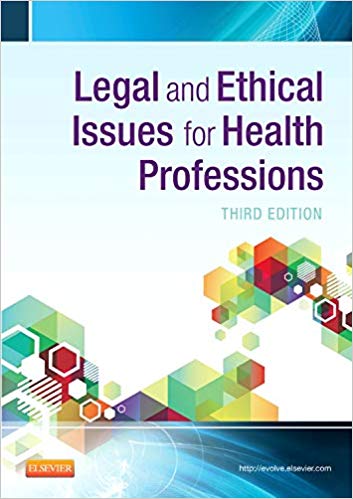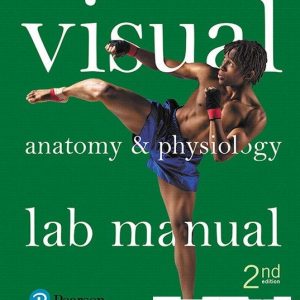This is completed downloadable of Test Bank for Legal and Ethical Issues for Health Professions 3rd Edition

Product Details:
- ISBN-10 : 1455733660
- ISBN-13 : 978-1455733668
- Author:
With coverage of both legal and ethical issues, this text gives you the foundation to handle common health care challenges in everyday practice. The new edition also includes a variety of exercises to help reinforce text content, as well as updated examples and case studies to help you apply information to professional practice.
- Detailed coverage of current legal and ethical issues and case law help facilitate classroom discussion and make concepts more relevant.
- What If? boxes present ethical dilemmas and help you apply concepts from the book to real-life examples.
- Updated case studies discuss the issues faced in a variety of healthcare settings.
- What If? boxes present ethical dilemmas and help you apply concepts from the book to real-life examples.
- Updated Case Studies discuss the issues faced in a variety of healthcare settings.
- A revised Imaging Liability and Litigation chapter describes how society holds healthcare workers accountable in the workplace.
- Important HIPAA information includes the latest privacy guidelines along with ethical and legal implications.
Table of Content:
- Chapter 1 The U.S. Legal System
- Chapter Objectives
- Key Terms
- Introduction
- What Is the Law?
- Discussion
- Sources of Law
- Branches of Government
- Box 1-1 Four Sources of Law
- Figure 1-1 Steps leading up to the U.S. Capitol.
- Constitution and Bill of Rights
- Box 1-2 Amendments to the Constitution
- Bill of Rights
- Other Amendments
- Box 1-3 Checks and Balances
- Checks and Balances
- Common Law versus Civil Code
- Box 1-4 Common Law Versus Civil Code
- Box 1-5 Civil Law versus Criminal Law
- Types of Law
- Criminal Law
- Relate to Practice
- Box 1-6 Remedies
- Civil Law
- Torts
- Box 1-7 Elements of Negligence
- What If?
- The Court System
- State Trial Courts
- Box 1-8 Jurisdiction
- Pretrial Discovery
- Box 1-9 How to Read a Case Citation
- Figure 1-2 The facts, as found by a jury or judge, cannot be appealed.
- Courts of Appeals
- State Supreme Courts
- Box 1-10 The U.S. Federal Courts
- Federal District Court System
- The U.S. Supreme Court
- What If?
- What If?
- Conclusion
- Chapter Review Questions
- Self-Reflection Questions
- Internet Activities
- Additional Resources
- Chapter 2 The Basics of Ethics
- Chapter Objectives
- Key Terms
- Introduction
- What Are Ethics?
- Discussion
- Codes of Ethics
- Medical Codes of Ethics
- Tolerance
- Medical Ethics
- Standards of Practice
- Medical Practice Acts
- Ethics and the Challenges of Subjectivity
- Repeated Wrongs
- Ignoring a Witnessed Wrong
- What If?
- What If?
- Subjectivity and the Needs Hierarchy
- Figure 2-1 Maslow’s Hierarchy of Needs.
- Bioethics
- Ethics versus Law
- Discussion
- Relate to Practice
- Relate to Practice
- Medical Etiquette
- Ethical Decision Making
- Principles of Healthcare Ethics
- Discussion
- Ethical Theories
- Ethical Theories
- Utilitarianism (Teleology)
- Medical Application
- What If?
- Duty-Based Ethics or Deontology
- Medical Application
- Rights-Based Ethics
- Medical Application
- Discussion
- Justice-Based Ethics
- Medical Application
- Figure 2-2 Justice-based ethics is meant to prevent injustice under social contracts, such as the distribution of organ donations. One individual should not have a greater advantage over another.
- Virtue-Based Ethics
- Medical Application
- Relate to Practice
- Ethical Decision-Making Models
- The Seven-Step Decision-Making Model
- Dr. Bernard Lo Clinical Model
- Medical Etiquette in Decision Making
- Ethics Committees and Quality Assurance
- Ethics Committees
- Accreditation
- Risk Management and Quality Assurance Programs
- Discussion
- Conclusion
- Chapter Review Questions
- Self-Reflection Questions
- Internet Activities
- Additional Resources
- Bibliography
- Chapter 3 Ethical and Bioethical Issues
- Chapter Objectives
- Key Terms
- Introduction
- Bioethics
- Medical Research
- Discussion
- Informed Consent and Blind Studies
- Figure 3-1 In a blind study, patients may receive no drug (the control group), the new trial drug, or a placebo.
- What If?
- Conflict of Interest
- Discussion
- Wakefield Study
- Ethical Issues in Reproductive Medicine
- Contraception and Sterilization Issues
- Voluntary Sterilization
- Involuntary Sterilization
- Contraception and Abortion
- Discussion
- Conception Issues
- Artificial Insemination
- Discussion
- In Vitro Fertilization
- Figure 3-2 Man helping woman inject drugs in preparation for in vitro fertilization.
- Relate to Practice
- Surrogate Motherhood
- What If?
- Genetic Testing and Counseling
- Ethical Issues in Biomedical Advances and Genetics Research
- The Human Genome Project
- Stem Cell Research
- Discussion
- Ethical Issues in Death and Dying
- Decisions to Prolong Life
- Palliative and Hospice Care
- Advance Directives and Living Wills
- Figure 3-3 Advance directives let the healthcare professional know the patient’s wishes when the patient is no longer able to communicate.
- Do Not Resuscitate (DNR)
- Relate to Practice
- Euthanasia
- What If?
- Ethics in Healthcare Systems and Healthcare Reform
- Healthcare Systems
- Relate to Practice
- Healthcare Reform
- Conclusion
- Chapter Review Questions
- Self-Reflection Questions
- Internet Activities
- Bibliography
- Additional Resources
- Chapter 4 Workplace Issues
- Chapter Objectives
- Key Terms
- Introduction
- Professionalism
- What If?
- Hiring and Firing
- Discrimination
- Illegal Interview Questions
- Antidiscrimination Legislation
- Sexual Harassment
- Qui Tam
- Figure 4-1 Sexual harassment is an offense of discrimination according to the Civil Rights Amendment of 1964.
- Discussion
- What If?
- Safety in the Workplace
- Figure 4-2 All physical hazard spaces, medical waste, and medical biohazards (such as used sharps) must be handled following specific guidelines initiated by OSHA.
- What If?
- Documentation
- Medical Record
- Elements of the Medical Record
- SOAP and CHEDDAR Formats
- SOAP
- CHEDDAR
- Reasons for Documentation
- Correction and Amendments to the Medical Record
- Ownership
- Privacy and Release of Information
- Health Insurance Portability and Accountability Act of 1996 (HIPAA)
- The Privacy Rule
- What If?
- National Provider Identifier (NPI)
- What If?
- Retention and Maintenance of Medical Records
- Conclusion
- Chapter Review Questions
- Self-Reflection Questions
- Internet Activities
- Additional Resources
- Chapter 5 Code and Standards Infractions
- Chapter Objectives
- Key Terms
- Introduction
- Disciplinary Action
- Workplace Standards
- Reasons for Disciplinary Actions
- Figure 5-1 Policies and procedures should be well-defined in the employee’s handbook or other employment packets and should include a description of duties or responsibilities as well as the code of ethics or defined standards.
- Examples of Work-Related Offenses That Could Warrant Disciplinary Action*
- Examples of Work-Related Offenses Specific to Healthcare Professions That Could Warrant Disciplinary Action*
- Compliance Plan
- Due Process
- What If?
- Compliance Officer
- What If?
- Monitoring the Employer or Institution
- Fraud
- Figure 5-2 Examples of fraud include billing for services not provided, up-coding services for larger reimbursement, or down-coding (under coding) for services provided.
- Infractions
- Abuse of Privilege
- Regulating Agencies
- Discussion
- Conclusion
- Chapter Review Questions
- Self-Reflection Questions
- Internet Activities
- Additional Resources
- Chapter 6 The Medical Malpractice Lawsuit and the Trial Process
- Chapter Objectives
- Key Terms
- Introduction
- Malpractice and Negligence
- What If?
- Duty
- Respondeat superior
- Figure 6-1 In respondeat superior, the individual with the highest license or training and/or the owner or highest authority of an organization is ultimately the individual responsible for actions of their subordinate workers.
- What If?
- Categories of Duty
- Discussion
- Dereliction of Duty
- Direct Cause
- Damages
- Establishing a Case
- Relate to Practice
- Defenses for Malpractice
- Denial
- Affirmative Defense
- Emergency Care
- Good Samaritan Laws
- Comparative Negligence or Contributory Negligence
- Figure 6-2 A Good Samaritan law, active in most states, provides immunity to medical professionals who provide healthcare in an emergency without reimbursement or without proper facilities available.
- Relate to Practice
- Assumption of Risk
- What If?
- Professional Liability
- Prevention of Liability and Malpractice
- Role of the Risk Management Supervisor
- Figure 6-3 The duties of the risk management supervisor would include monitoring all aspects of prevention of malpractice and guarding the practice against issues of fraud and abuse.
- Duties of a Risk Management Supervisor
- Safety of Staff and Patients
- Communication
- Documentation
- Conclusion
- Chapter Review Questions
- Self-Reflection Questions
- Internet Activities
- Additional Resources
- Chapter 7 Intentional and Quasi-Intentional Torts
- Chapter Objectives
- Key Terms
- Introduction
- Definition of a Tort
- Box 7-1 Intentional and Quasi-Intentional Torts
- Intentional Torts
- Intent
- Figure 7-1 To determine intent, we do not necessarily have to establish that the accused individual had a desire to cause harm or injury to a person.
- Assault
- Battery
- Discussion
- Consent: A Primary Defense Against Battery
- What If?
- Implied Consent
- Sexual Assault and Battery (Misconduct)
- Relate to Practice
- False Imprisonment
- Defenses Against False Imprisonment Charges
- Restraints in the Home-Care Setting
- Against Medical Advice
- Intentional Infliction of Emotional Distress
- Figure 7-2 In the case of a minor, the hospital can attempt to get a court order to require the family to keep the child in the hospital, but any attempt to physically restrain the child or the parent in the absence of a court order exposes the hospital to liability.
- Trespass to Land
- Quasi-Intentional Torts
- Defamation
- Defenses of Defamation
- Invasion of Privacy
- Appropriating Likeness and Placing a Person in a False Light
- What If?
- Publicizing Private Facts
- Breach of Confidentiality
- Figure 7-3 Whether a healthcare provider has access to the traditional written medical record or to computerized records, the responsibility to keep information confidential does not change.
- Intentional and Quasi-Intentional Torts and Insurance Policies
- What If?
- What If?
- Conclusion
- Chapter Review Questions
- Self-Reflection Questions
- Internet Activities
- Bibliography
- Additional Resources
- Chapter 8 Statutory Reporting and Public Duties
- Chapter Objectives
- Key Terms
- Introduction
- Statutory Report Duties
- Vital Statistics and Public Health Records
- Figure 8-1 The attending physician or midwife completes the initial birth certificate and then submits it to the local (usually county) agency for recording. From there the government’s official certificate of birth is released.
- Births
- Deaths
- Communicable Diseases
- What If?
- Discussion
- Sexually Transmitted Diseases/AIDS
- Discussion
- HIV/AIDS and the Healthcare Worker
- Abuse
- Discussion: Case Study—Kimberly Ann Bergalis
- Identifying Victims of Abuse
- Child Abuse
- Elder Abuse
- Figure 8-2 Everyone in the healthcare profession is required to report incidents, or suspicion, of child abuse to the appropriate authorities. In addition, as with other cases, the child should be asked—while alone—whether he or she feels safe.
- Relate to Practice
- Spousal or Partner Abuse
- Sexual Assault and Abuse
- Substance Abuse
- TABLE 8-1 Drug Classifications According to the Controlled Substances Act of 1970
- TABLE 8-2 Amendments to the Controlled Substances Act of 1970
- Conclusion
- Chapter Review Questions
- Self-Reflection Questions
- Internet Activities
- Additional Resources
- Chapter 9 Professional Liability Insurance
- Chapter Objectives
- Key Terms
- Liability Insurance
- Is Your Employer’s Liability Insurance All You Need?
- Independent Contractors
- Employers’ Liability Policies
- Limits of Policy Exceeded
- Mergers and Closures
- Conflicts Over Liability
- Conflicts Over Proposed Settlements
- Figure 9-1 Because employee and employer may disagree about the facts of an incident, it is far better to have your own policy and your own attorney, whose loyalty will be only to you, the employee.
- Conflicts Between Multiple Employees Over an Incident
- Employers’ Self-Insurance
- Discussion
- Professional Liability Insurance
- Key Features of a Private Policy
- Cost
- Disciplinary Defense Insurance
- Figure 9-2 Always examine the key features of an insurance policy before signing anything, and know ahead of time what features you should expect to find.
- Policy Limits
- Coverage
- Peace of Mind
- What If?
- Applying for Professional Liability Insurance
- Details to Provide When Applying for Professional Liability Insurance
- Types of Private Liability Policies
- Tail Coverage
- Occurrence Basis Policy
- Prior Acts Coverage
- Relate to Practice
- Umbrella Policy
- Additional Coverage
- Components of a Typical Professional Liability Policy
- Declarations Page
- Policy Provisions
- Figure 9-3 The policy jacket is the section that sets forth the generic provisions found in most policies of the same type.
- Statement of the Agreement
- Exclusions
- Duties and Cooperation of Insured
- Definitions
- Nonrenewal or Cancellation
- Right to Defend or Settle
- Other Insurance
- Expenses of Defending a Claim
- Premium Payments
- Endorsements
- Conclusion: Before Purchasing a Policy
- Chapter Review Questions
- Self-Reflection Questions
- Internet Activities
- Bibliography
- Chapter 10 Death and Dying Issues
- Chapter Objectives
- Key Terms
- Introduction
- Determination of Death
- Grief
- Advance Medical Directives
- Figure 10-1 Both the individual facing the reality of impending death as well as those who care about the individual tend to experience a series of fairly predictable emotional “stages” of grief.
- Living Will
- Healthcare Proxy
- Durable Power of Attorney (DPOA)
- Do Not Resuscitate (DNR)
- What if?
- Relate to Practice
- Relate to Practice
- Hospice
- Figure 10-2 Hospice care provides support for both patients and their loved ones.
- Discussion
- Euthanasia
- Passive and Active Euthanasia
- Physician-Assisted Suicide
- Landmark Court Decisions Related to Death and Dying
- Karen Ann Quinlan
- Nancy Cruzan
- Terri Schiavo
- Organ and Tissue Donation
- Figure 10-3 The Organ Procurement and Transplantation Network (OPTN) maintains a national registry for organ matching.
- Discussion
- Conclusion
- Chapter Review Questions
- Self-Reflection Questions
- Internet Activities
- Additional Resources
- Chapter 11 Conflict Management
- Chapter Objectives
- Key Terms
- Introduction
- What Is Conflict?
- Contributing Factors
- Figure 11-1 The wide variety of knowledge, power, and control held by the various participants in healthcare introduces institutionalized differences in how to handle some situations.
- Discussion
- Positive vs. Negative Conflict
- Relate to Practice
- Relate to Practice
- Conflict Behavioral Styles
- Competing
- Accommodating
- Avoiding
- Compromising
- Collaborating
- Adjustments Based on Behavioral Styles
- Discussion
- Emotional, Cognitive, and Physical Responses to Conflict
- Emotional Responses
- Cognitive Responses
- Physical Responses
- Disruptive Behavior
- Relate to Practice
- Conflict Management
- Discussion
- Conflict Resolution
- Alternative Dispute Resolution
- Negotiation
- Mediation
- Figure 11-2 A mediator may offer a possible resolution for discussion, help parties explore options, identify issues, and provide information.
- Facilitation
- Arbitration
- What If?
- Conclusion
- Chapter Review Questions
- Self-Reflection Questions
- Internet Activities
- Additional Resources
- Bibliography
- Chapter 12 Business Aspects of Healthcare
- Chapter Objectives
- Key Terms
- Introduction
- Types of Providers
- Medical Doctors
- Specialists
- Figure 12-1 Specialists are fully licensed MD or DO medical doctors who have undergone further schooling and training in a specific area of medicine.
- Other Types of Providers
- Mid-Level Providers
- Figure 12-2 Mid-level providers are not physicians, but they may perform similar services such as writing prescriptions, and they usually bill insurance companies for their services. Examples of mid-level providers include physical therapists.
- Allied Health Professionals
- Corporate Structure
- Using Mid-Level Providers
- Fee Splitting
- What If?
- Discussion
- Types of Practice Structures
- Solo Practice
- Sole Proprietorship
- Figure 12-3 In a sole proprietorship, the provider has legal agreements to hire other physicians or mid-level providers to work for them.
- Associate Practice
- Group Practice
- Other Structures
- Types of Insurance Coverage
- Commercial Patient Plans
- Point-of-Service Health Insurance
- Box 12-1 Megan’s Office Visit Is Covered
- Box 12-2 Megan’s Office Visit—Without Health Insurance
- Box 12-3 Megan’s Office Visit—Insurance Allows Reimbursement
- Health Maintenance Organizations
- Other Commercial Payers
- Workers’ Compensation
- Government Carriers
- Medicaid
- Medicare
- TRICARE
- Conclusion
- Chapter Review Questions
- Self-Reflection Questions
- Internet Activities
- Additional Resources
- Appendix A Resource Section
- Appendix B The Trial Process
- Appendix C Case Discussions
- Case Discussion 1: Altercation with Patient
- Case Discussion 2: Student Terminated from Program
- Case Discussion 3: Notification of Abnormality in X-Ray
- Case Discussion 4: Sexual Act with Patient
- Case Discussion 5: Radioiodine Therapy for Pregnant Patient
- Case Discussion 6: Treatment of Suicidal Patient
- Case Discussion 7: Dental Surgery Follow-Up
- Case Discussion 8: Dental Diagnosis and Treatment
- Case Discussion 9: Alleged Injury during Treadmill Test
- Case Discussion 10: Torn Rotator Cuff
- Case Discussion 11: Misplaced MRI
- Case Discussion 12: Misplaced Mammogram Report
- Case Discussion 13: Recordkeeping at Nursing Home
- Case Discussion 14: Testing Errors
- Appendix D Case Studies
- Case Study 1: EMT Liability for Death
- Are EMTs who have disconnected oxygen liable for the death of a terminally ill patient?
- Case Study 1 Questions
- Case Study 2: Informed Consent
- Does a student or preceptor have a duty to obtain informed consent?
- Case Study 2 Questions
- Case Study 3: Intentional Tort
- Is an intentional tort malpractice?
- Case Study 3 Questions
- Case Study 4: Intentional Tort
- Who is liable for the intentional torts of hospital staff?
- Case Study 4 Questions
- Case Study 5: Laboratory Results
- Does a laboratory have an affirmative duty to disclose positive HIV test results?
- Case Study 5 Questions
- Case Study 6: Legal Obligations of an Educational Facility
- What is the legal obligation of an educational facility to its students?
- Case Study 6 Questions
- Case Study 7: Medical Product Liability
- What are the limits on medical product liability cases under federal law?
- Case Study 7 Questions
- Case Study 8: Mobile Screening Unit Duties
- Does the healthcare provider have a duty to inform a screened employee of abnormal test results?
- Case Study 8 Questions
- Case Study 9: Ordinary Negligence vs. Malpractice
- Is it ordinary negligence or malpractice?
- Case Study 9 Questions
- Case Study 10: Privacy
- Is disclosure of a patient’s confession to a crime a violation of the right to privacy?
- Case Study 10 Questions
- Case Study 11: Res Ipsa Loquitur
- Is the doctrine of res ipsa loquitur applicable to establish negligence?
- Case Study 11 Questions
- Case Study 12: Respiratory Therapy/Radiology
- Who committed malpractice?
- Case Study 12 Questions
- Case Study 13: Spoliation
- How does the spoliation of evidence affect a lawsuit?
- Case Study 13 Questions
- Case Study 14: Statute of Limitations
- Does a plaintiff healthcare professional have a greater duty to discover a potential claim for malpractice for purposes of the statute of limitations?
- Case Study 14 Questions
- Appendix E Supplemental Case Scenarios
- Case Scenario 1: Student’s Unsatisfactory Performance
- Case Scenario 2: Signing Consent Forms
- Case Scenario 3: Patient Noncompliance
- Case Scenario 4: Anesthetic for Brain-Damaged Patient
- Case Scenario 5: Treatment and Religious Freedom
- Case Scenario 6: Patient Privacy
- Case Scenario 7: Administering Incorrect Medication
- Case Scenario 8: Employee Privacy
- Case Scenario 9: Equipment Malfunction
- Case Scenario 10: Failure to Monitor Patient
- Case Scenario 11: Discussing Treatment Options
- Case Scenario 12: Advance Directives
- Case Scenario 13: Life-Prolonging Treatment
- Case Scenario 14: Scope of Practice
- Case Scenario 15: X-Ray and Diagnosis
- Case Scenario 16: Distributing Medication
- Case Scenario 17: Alarms and Patient Safety
- Glossary
- A
- B
- C
- D
- E
- F
- G
- H
- I
- J
- L
- M
- N
- O
- P
- Q
- R
- S
- T
- U
- V
- W
- Index
- A
- B
- C
- D
- E
- F
- G
- H
- I
- J
- K
- L
- M
- N
- O
- P
- Q
- R
- S
- T
- U
- V
- W





